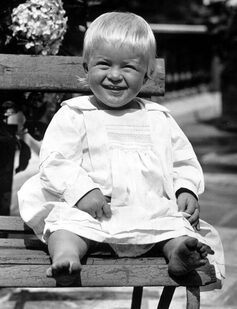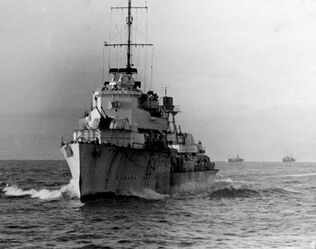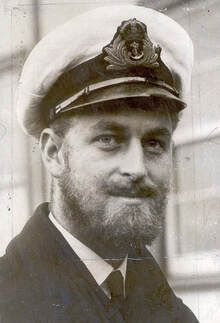A Tribute to Philip, Warrior Prince
 Prince Philip was born into war. When Princess Alice of Battenberg gave birth to him on the Greek island of Corfu on June 10, 1921, the Greco-Turkish War had already been raging for two years. His father, Prince Andrew of Greece, commanded a Greek Army division and his uncle, King Constantine I, was the high commander of the Greek expeditionary force. The only son and fifth child, Philip’s parents had him baptized into the Greek Orthodox Church. As a member of the House of Schleswig-Holstein-Sonderburg-Glücksburg, he was in line of succession to both the Greek and the Danish thrones.
Prince Philip was born into war. When Princess Alice of Battenberg gave birth to him on the Greek island of Corfu on June 10, 1921, the Greco-Turkish War had already been raging for two years. His father, Prince Andrew of Greece, commanded a Greek Army division and his uncle, King Constantine I, was the high commander of the Greek expeditionary force. The only son and fifth child, Philip’s parents had him baptized into the Greek Orthodox Church. As a member of the House of Schleswig-Holstein-Sonderburg-Glücksburg, he was in line of succession to both the Greek and the Danish thrones.But the war was going badly, and when Philip was just 18 months old, Greeks revolted against their King. Constantine was forced to abdicate, and Prince Andrew, his wife, four daughters, and infant son were banished. The family escaped on the British naval vessel HMS Calypso, where the infant Philip slept in a cot made from a fruit box. In Paris, an aunt took them in.
 The HMS Wallace. It had the nickname "One round Wallace", as the very first shot it fired in the war brought down a German airplane The family spiraled down after that. Philip was shuffled from school to school, beginning in Paris, then moved first to a British school, then a German one. As the Nazi party grew, his school moved to Scotland, and from there he moved to the Royal Naval College in Dartmouth. As he shuffled from school to school, his four sisters married German princes and joined the Nazi party, his mother was committed to an asylum for schizophrenia, and his father moved to Monte Carlo. The young prince was left in the care of his uncle and guardian, Lord Milford Haven. When Haven died of cancer, his brother Louis Mountbatten, took over Philip’s guardianship, and Philip took the name Mountbatten as his own.
The HMS Wallace. It had the nickname "One round Wallace", as the very first shot it fired in the war brought down a German airplane The family spiraled down after that. Philip was shuffled from school to school, beginning in Paris, then moved first to a British school, then a German one. As the Nazi party grew, his school moved to Scotland, and from there he moved to the Royal Naval College in Dartmouth. As he shuffled from school to school, his four sisters married German princes and joined the Nazi party, his mother was committed to an asylum for schizophrenia, and his father moved to Monte Carlo. The young prince was left in the care of his uncle and guardian, Lord Milford Haven. When Haven died of cancer, his brother Louis Mountbatten, took over Philip’s guardianship, and Philip took the name Mountbatten as his own.
While he was at Dartmouth, King George VI and Queen Elizabeth visited, and Philip was asked to escort the King's two daughters, who were his third cousins through Queen Victoria. The king’s older daughter, Elizabeth, who was only 13, began exchanging letter with Philip soon after that.
In 1940, Philip graduated from Dartmouth as the best cadet in his class. He was appointed as a midshipman and served in the Indian Ocean aboard the battleship HMS Ramillies,the HMS Kent, and the HMS Shropshire. After Italy invaded Greece in October, he transferred to the battleship HMS Valiant, which was sailing in the Mediterranean. He fought in the Battle of Crete, and the March, 1941 Battle of Cape Matapan, where the 19-year-old sub-lieutenant was in charge of manning the searchlights used to spot enemy ships. He found two different targets, which his battleship was able to sink, earning himself the Greek War Cross.
By July 1943, Philip was a first lieutenant serving on the destroyer HMS Wallace. During the Allied Invasion of Sicily, the Wallace was targeted by a Luftwaffe bomber who repeatedly attacked. Philip came up with the idea of assembling a wooden raft, which they loaded with smoke pots and launched. Apparently, the German pilot mistook the smoking, flaming raft for the Wallace, which was able to slip away in the dark of night.
 The 1945 picture of Philip that Elizabeth kept on her dressing table throughout the last year of the war. In 1944, Prince Philip was transferred to the Pacific, where he served aboard the HMS Whelp. Two rescued British airmen whose bomber was shot down by the Japanese over the ocean discovered who he was only after they saw Princess Elizabeth's photo in his cabin, where he had left them as he collected hot food and dry clothes for them. Elizabeth had a picture of the bearded lieutenant on her dressing table, but no down pilots sat on her bed while awaiting supplies.
The 1945 picture of Philip that Elizabeth kept on her dressing table throughout the last year of the war. In 1944, Prince Philip was transferred to the Pacific, where he served aboard the HMS Whelp. Two rescued British airmen whose bomber was shot down by the Japanese over the ocean discovered who he was only after they saw Princess Elizabeth's photo in his cabin, where he had left them as he collected hot food and dry clothes for them. Elizabeth had a picture of the bearded lieutenant on her dressing table, but no down pilots sat on her bed while awaiting supplies.After the war ended, Philip asked the King for his daughter's hand in marriage. The King asked that a formal engagement be delayed until Elizabeth's 21st birthday, in April of 1947.
Philip had to relinquish his Greek and Danish royal titles, but he did not give up his position in the Navy. After his marriage on November 20, 1947, he continued to serve, first at the Admiralty, and then at the Navel Staff College in Greenwich. He eventually was promoted to commander, and commanded the frigate HMS Magpie. In 1952, Elizabeth’s father, King George VI died and Elizabeth ascended the throne. Philip then gave up his military career to support his wife, but he continued to hold many honorary titles in the Army, the Navy and the Air Force. He also received pilot training with the RAF, and continued flying until the late 1990s. He remained a warrior at heart throughout his life. Jennifer Bohnhoff is an educator and writer who lives far from the sea, in the mountains of central New Mexico. When she was a young girl attending Oxford University in the late 1970s, it was rumored that Philip might just become her father in law. You can read more about that here. For more about her books, visit her website.
Published on April 18, 2021 13:18
No comments have been added yet.



